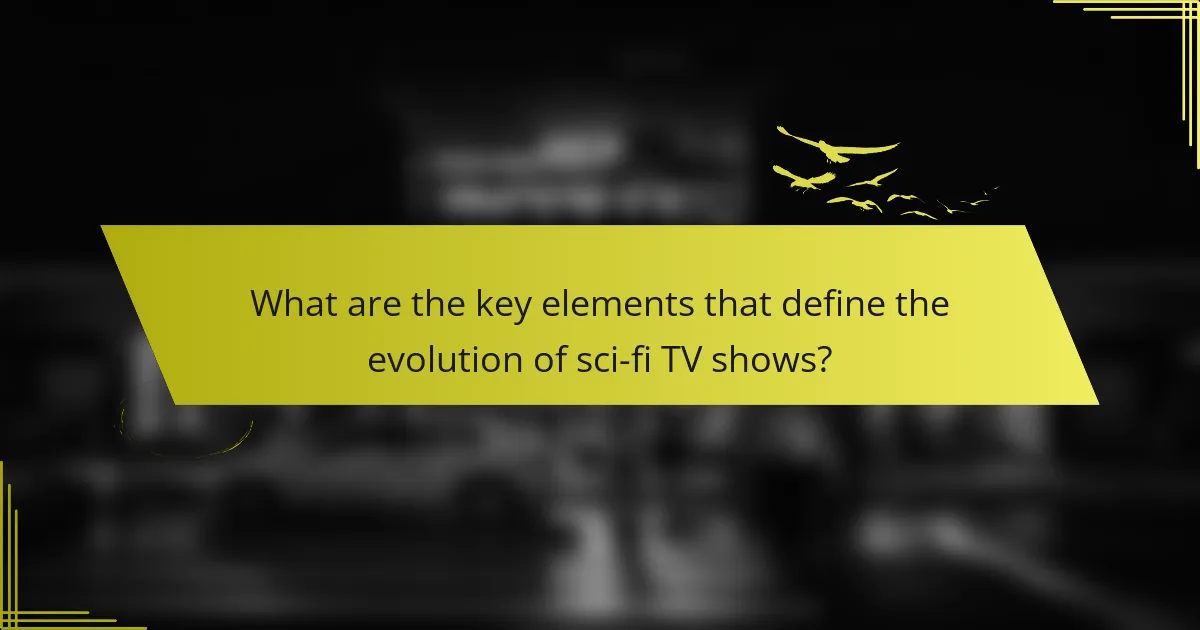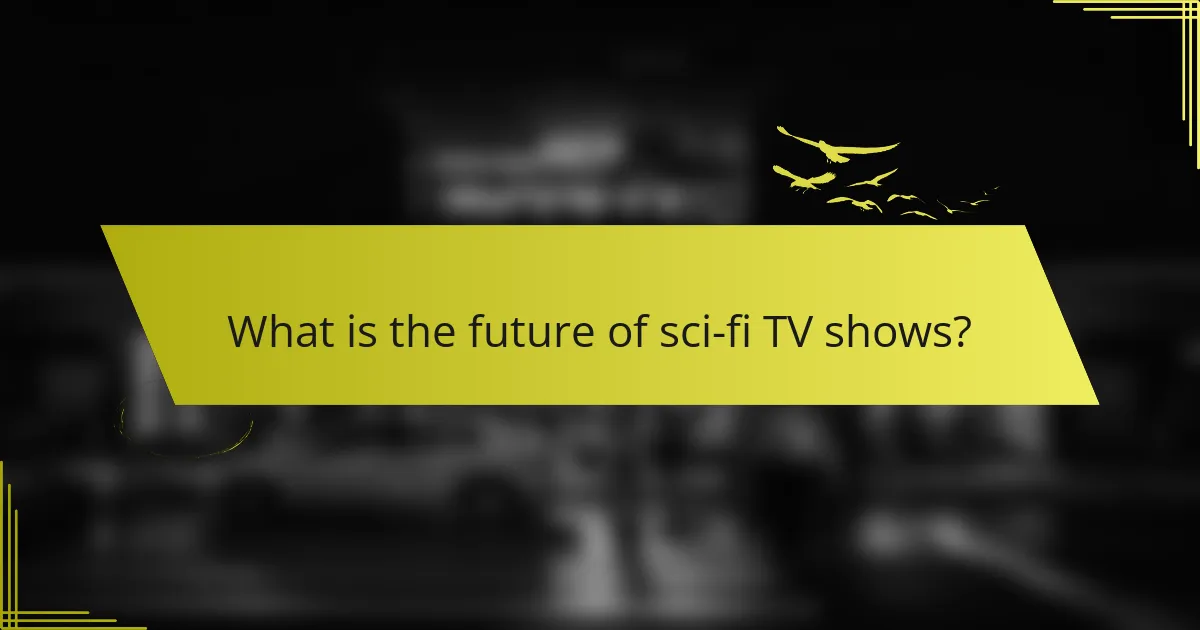The article examines the evolution of science fiction (sci-fi) television shows, focusing on key elements such as technological advancements, narrative complexity, and cultural reflection. It highlights how innovations like CGI have transformed visual storytelling, while shows such as “The Expanse” and “Black Mirror” illustrate deeper thematic exploration and societal critiques. Additionally, the article discusses how historical context has shaped sci-fi narratives, addressing issues like civil rights and public distrust in institutions. Looking ahead, the future of sci-fi TV is expected to embrace greater diversity in storytelling and enhanced viewer experiences through technological innovations.

What are the key elements that define the evolution of sci-fi TV shows?
The key elements that define the evolution of sci-fi TV shows include technological advancements, narrative complexity, and cultural reflection. Technological advancements have enabled more sophisticated visual effects and storytelling techniques. For example, the introduction of CGI in the 1990s revolutionized the genre. Narrative complexity has increased, with shows exploring deeper themes and character development. Series like “The Expanse” demonstrate this trend through intricate plots and moral dilemmas. Cultural reflection is also crucial, as sci-fi often addresses contemporary societal issues. Programs like “Black Mirror” critique technology’s impact on society. These elements collectively illustrate how sci-fi TV shows have evolved over time.
How have technological advancements influenced sci-fi TV shows over the decades?
Technological advancements have significantly influenced sci-fi TV shows over the decades. Early sci-fi shows like “Star Trek” utilized practical effects and innovative storytelling to depict futuristic concepts. The introduction of CGI in the 1990s transformed visual storytelling, allowing for more complex and imaginative worlds. Shows like “Babylon 5” and “Star Wars: The Clone Wars” showcased the potential of digital effects. Streaming technology has changed how audiences consume sci-fi content, with platforms like Netflix producing high-quality series such as “Stranger Things.” Additionally, advancements in sound design and editing have enhanced the overall viewing experience. These technological developments have expanded the creative possibilities for writers and producers, leading to richer narratives and more immersive worlds.
What specific technologies have been prominently featured in sci-fi TV shows?
Prominent technologies featured in sci-fi TV shows include artificial intelligence, virtual reality, and space travel. Artificial intelligence is often portrayed through sentient robots and advanced computer systems. Examples include the character Data from “Star Trek: The Next Generation.” Virtual reality technologies are depicted in shows like “Black Mirror,” showcasing immersive experiences. Space travel technologies are central to series such as “Battlestar Galactica” and “The Expanse,” highlighting faster-than-light travel and spacecraft. Other notable technologies include time travel, seen in “Doctor Who,” and genetic engineering, explored in “Altered Carbon.” These technologies reflect societal hopes and fears about the future.
How have these technologies shaped narratives and viewer expectations?
Technologies have significantly shaped narratives and viewer expectations in sci-fi TV shows. Advanced visual effects have enabled more imaginative storytelling. This technology allows creators to depict complex alien worlds and futuristic scenarios. For instance, the use of CGI in shows like “The Mandalorian” has transformed visual storytelling. Additionally, streaming platforms have changed how narratives are structured. Binge-watching encourages deeper character development and intricate plots. Viewers now expect serialized storytelling with cliffhangers and character arcs. Data analytics from streaming services also inform creators about audience preferences. This leads to more tailored content that meets viewer demands. Overall, technology has redefined narrative possibilities and audience engagement in sci-fi television.
What themes are commonly explored in sci-fi TV shows?
Common themes explored in sci-fi TV shows include the impact of technology on society, exploration of space, and the nature of humanity. These themes often address ethical dilemmas related to advancements in artificial intelligence and biotechnology. Many shows depict dystopian futures, highlighting societal issues like totalitarianism and environmental collapse. Time travel is another frequent theme, allowing narratives to explore alternate histories and futures. Additionally, alien encounters often serve as a metaphor for cultural differences and conflict. These themes reflect contemporary anxieties and aspirations, making them relevant to audiences. Sci-fi TV shows like “Black Mirror” and “The Expanse” exemplify these explorations through their storytelling.
How do themes of dystopia and utopia manifest in popular series?
Themes of dystopia and utopia manifest in popular series through contrasting societal structures and moral dilemmas. Dystopian narratives often depict oppressive governments, environmental disasters, or societal collapse. These elements are evident in series like “The Handmaid’s Tale,” which explores totalitarianism and gender oppression. Utopian themes, on the other hand, envision ideal societies that promote equality and harmony. Shows like “Star Trek” present advanced civilizations that prioritize cooperation and exploration. The interplay between dystopia and utopia challenges viewers to reflect on current societal issues. This reflection is crucial in series such as “Black Mirror,” which critiques modern technology’s impact on humanity. Overall, these themes serve as a lens to examine human nature and societal values.
What role does space exploration play in the storytelling of sci-fi TV shows?
Space exploration serves as a fundamental backdrop in sci-fi TV shows. It allows for the exploration of complex themes such as humanity’s place in the universe. The vastness of space creates opportunities for diverse storytelling, including encounters with alien civilizations. Shows like “Star Trek” and “The Expanse” leverage space to address social issues and philosophical questions. These narratives often reflect contemporary concerns about technology and ethics. Space exploration also fosters a sense of adventure and discovery. It captivates audiences with the possibilities of unknown worlds and future technologies. Overall, space exploration enriches the narrative depth and thematic diversity of sci-fi television.
Who are the iconic characters that have emerged from sci-fi TV shows?
Iconic characters from sci-fi TV shows include Spock from “Star Trek,” Doctor Who from “Doctor Who,” and The Doctor’s companions. Spock, portrayed by Leonard Nimoy, represents logic and reason as a Vulcan. Doctor Who, a time-traveling alien, has been portrayed by various actors since 1963. The character’s ability to regenerate allows for continual evolution. Other notable characters include the X-Files’ Mulder and Scully, who investigate paranormal phenomena. Each character has shaped the genre, influencing pop culture and audience perceptions of science fiction. Their unique traits and story arcs have made them memorable in television history.
What characteristics make these characters memorable and influential?
Memorable and influential characters in sci-fi TV shows possess distinct traits. They often embody complex personalities that resonate with audiences. These characters frequently face moral dilemmas, prompting viewers to reflect on ethical questions. Their development over time allows for deeper connections with fans. Unique abilities or knowledge often set them apart, making them intriguing. Strong relationships with other characters enhance their narrative significance. Iconic quotes or catchphrases contribute to their lasting impact. Finally, cultural relevance ensures they remain significant in societal discussions.
How have these characters evolved alongside the genre?
Characters in sci-fi TV shows have evolved significantly alongside the genre. Early characters often embodied simplistic archetypes, such as the hero or the villain. These characters typically reflected societal fears and aspirations of their time. For example, the 1960s series “Star Trek” introduced diverse characters that challenged social norms.
As the genre progressed, characters became more complex and nuanced. The 1990s saw the rise of anti-heroes, such as those in “The X-Files.” These characters often grappled with moral ambiguity and personal dilemmas. In recent years, shows like “The Expanse” feature multi-dimensional characters with rich backstories and varied motivations.
This evolution mirrors broader cultural shifts, including increased representation and deeper explorations of identity. Current characters often address contemporary issues, such as climate change and technology’s impact on society. Overall, the development of characters in sci-fi TV reflects the genre’s growth and its response to changing societal values.

How have sci-fi TV shows reflected cultural changes and societal issues?
Sci-fi TV shows have reflected cultural changes and societal issues by addressing contemporary fears and aspirations. For instance, shows like “The Twilight Zone” tackled themes of civil rights and paranoia during the Cold War. “Star Trek” introduced diversity and inclusivity, showcasing a future where different species coexist.
In the 1980s, “The X-Files” mirrored public distrust in government and institutions. More recently, “Black Mirror” explores the impact of technology on society, highlighting ethical dilemmas and human behavior. These narratives often serve as a critique of current societal norms and trends, prompting viewers to question reality.
By engaging with pressing issues such as climate change, inequality, and identity, sci-fi TV shows remain relevant and reflective of their times.
In what ways do sci-fi TV shows address contemporary social issues?
Sci-fi TV shows address contemporary social issues by using futuristic settings to mirror current societal challenges. They often explore themes such as inequality, environmental concerns, and technological ethics. For instance, “Black Mirror” critiques the impact of technology on human relationships and privacy. “The Expanse” tackles issues of class struggle and resource distribution in a colonized solar system. Additionally, shows like “Star Trek” have historically addressed racism and diversity through allegorical storytelling. These narratives encourage viewers to reflect on real-world problems by presenting them in an exaggerated or speculative context. Through this lens, sci-fi becomes a platform for social commentary and critique.
How have shows tackled themes of identity and diversity?
Shows have tackled themes of identity and diversity by exploring various cultural backgrounds and experiences. They often feature characters from diverse racial, ethnic, and gender identities. This representation allows for a broader understanding of societal issues. For example, series like “Star Trek” introduced multicultural crews, promoting inclusivity. “The Expanse” presents a future where different factions represent varied cultural identities. These portrayals challenge stereotypes and encourage dialogue about acceptance. Research indicates that diverse representation in media positively influences viewers’ perceptions of different identities. Shows that embrace these themes contribute to cultural awareness and empathy.
What impact do these representations have on audience perceptions?
Representations in sci-fi TV shows significantly influence audience perceptions. They shape viewers’ understanding of technology, society, and identity. For instance, shows like “Star Trek” have promoted inclusivity and diversity. This representation can challenge stereotypes and broaden perspectives. Studies indicate that diverse characters lead to greater acceptance of different cultures. Additionally, portrayals of advanced technology can spark interest in scientific fields. Research shows that positive representations can inspire future generations to pursue STEM careers. Overall, these representations play a crucial role in shaping societal norms and values.
How do sci-fi TV shows influence and inspire real-world innovations?
Sci-fi TV shows influence and inspire real-world innovations by presenting futuristic concepts and technologies. These shows often explore advanced ideas, such as artificial intelligence, space travel, and virtual reality. For instance, “Star Trek” introduced the concept of communicators, which inspired the development of mobile phones. Similarly, “Black Mirror” examines the societal implications of technology, prompting discussions that lead to real-world ethical standards. Research conducted by the University of Southern California found that sci-fi narratives can stimulate interest in STEM fields. This demonstrates the connection between creative storytelling and technological advancement.
What examples exist of technologies inspired by sci-fi narratives?
Examples of technologies inspired by sci-fi narratives include cell phones, virtual reality, and smart home devices. Cell phones were inspired by the communicators in “Star Trek.” Virtual reality technology draws from immersive environments depicted in various sci-fi films and shows. Smart home devices reflect concepts seen in “The Jetsons.” Additionally, autonomous vehicles have roots in the self-driving cars portrayed in “Total Recall.” These technologies demonstrate the influence of science fiction on real-world innovations.
How do creators use sci-fi to speculate on future possibilities?
Creators use sci-fi to speculate on future possibilities by exploring advanced technologies and societal changes. They craft narratives that project current trends into hypothetical futures. For instance, shows like “Black Mirror” examine the implications of technology on human behavior. This genre often reflects concerns about ethics, governance, and environmental issues. Through imaginative scenarios, creators invite audiences to consider potential outcomes. Historical examples include “Star Trek,” which envisioned space exploration and multicultural cooperation. These narratives encourage critical thinking about real-world challenges. Sci-fi serves as a mirror, reflecting our hopes and fears about the future.

What is the future of sci-fi TV shows?
The future of sci-fi TV shows is expected to be characterized by increased diversity in storytelling and technological innovation. Streaming platforms are investing heavily in original sci-fi content. This trend is driven by audience demand for fresh narratives and complex characters. Advanced special effects and virtual reality will enhance viewer experiences. Data shows that sci-fi series have gained significant popularity, with shows like “The Expanse” and “Stranger Things” receiving critical acclaim. Additionally, themes addressing societal issues, such as climate change and artificial intelligence, will likely become more prevalent. These factors indicate a promising future for the genre, appealing to both new and existing audiences.
How are emerging trends shaping the next generation of sci-fi television?
Emerging trends are significantly shaping the next generation of sci-fi television. Streaming platforms are prioritizing diverse storytelling. This allows for a wider range of narratives and characters. High-quality production values are becoming standard. Advanced visual effects enhance the storytelling experience. Audience engagement through interactive content is on the rise. This trend encourages viewer participation and investment in plots. Additionally, themes of climate change and technology ethics are increasingly prevalent. These themes resonate with contemporary societal concerns. Data from recent studies shows a growing interest in these topics among viewers. This shift reflects a demand for more relevant and thought-provoking content.
What role will streaming platforms play in the evolution of sci-fi TV shows?
Streaming platforms will significantly shape the evolution of sci-fi TV shows. They provide creators with greater freedom to explore innovative narratives. This allows for diverse storytelling that traditional networks often restrict. Streaming services have invested heavily in original sci-fi content. For example, Netflix’s “Stranger Things” and Amazon’s “The Expanse” have gained massive popularity. These platforms also enable binge-watching, altering viewer engagement. Viewers can consume entire seasons at their own pace. This model encourages intricate plot development and character arcs. Furthermore, streaming platforms facilitate global distribution. Sci-fi shows can reach international audiences quickly and efficiently. This broadens the genre’s appeal and influences its evolution.
How might audience preferences influence future sci-fi narratives?
Audience preferences will significantly shape future sci-fi narratives. As viewers increasingly demand diverse representation, narratives will evolve to include a wider array of characters and stories. This shift reflects the growing awareness of social issues and the desire for inclusivity. Data shows that shows like “The Expanse” and “Black Mirror” gained popularity by addressing contemporary societal themes. Furthermore, audience engagement through platforms like social media allows for real-time feedback, influencing plot development and character arcs. Streaming services analyze viewer habits to tailor content, leading to more personalized sci-fi experiences. Overall, audience preferences will drive innovation and thematic exploration in future sci-fi narratives.
What can viewers look for in the next wave of sci-fi TV shows?
Viewers can look for innovative storytelling and diverse representation in the next wave of sci-fi TV shows. This evolution includes complex characters and intricate plots that challenge traditional narratives. Expect themes that explore social issues, technology, and human relationships. Many upcoming shows will incorporate cutting-edge visual effects and immersive world-building. The rise of streaming platforms allows for more experimental formats and episodic structures. Audiences will likely see a blend of genres, merging sci-fi with drama, horror, and comedy. Additionally, there is a growing emphasis on sustainability and environmental themes in new narratives. These trends reflect a shift towards more inclusive and thought-provoking content in the sci-fi genre.
How can audiences engage with sci-fi content in new ways?
Audiences can engage with sci-fi content in new ways through interactive storytelling platforms. These platforms allow viewers to influence plot outcomes and character decisions. Virtual reality (VR) experiences immerse audiences in sci-fi worlds. This technology enables users to explore settings and interact with characters. Augmented reality (AR) applications enhance real-world experiences with sci-fi elements. Fans can participate in live-action role-playing (LARP) events based on their favorite sci-fi narratives. Social media discussions foster community engagement and fan theories. Streaming services are now offering watch parties for collective viewing experiences. These innovative approaches deepen audience investment and connection to sci-fi content.
What are some recommended upcoming sci-fi shows to watch?
The recommended upcoming sci-fi shows to watch include “Dune: The Sisterhood,” “The Peripheral,” and “Strange New Worlds.” “Dune: The Sisterhood” is based on Frank Herbert’s universe and explores the Bene Gesserit sisterhood. “The Peripheral” is adapted from William Gibson’s novel, focusing on technology and its impact on society. “Strange New Worlds” continues the legacy of “Star Trek,” exploring new missions in the galaxy. These shows are highly anticipated due to their strong source material and creative teams.
The main entity of the article is the evolution of sci-fi TV shows, which encompasses key themes, iconic characters, and cultural impact. The article outlines how technological advancements, narrative complexity, and cultural reflection have shaped the genre over time. It discusses specific technologies featured in these shows, common themes such as dystopia and utopia, and the role of iconic characters in influencing audience perceptions. Additionally, the article examines how sci-fi narratives address contemporary social issues and reflect cultural changes, while also looking ahead to future trends in the genre, particularly regarding diversity and audience engagement through streaming platforms.



